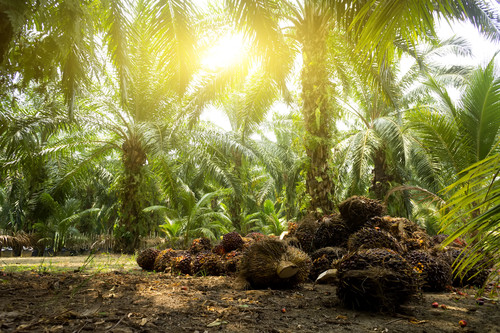Popular Reads
Top Results
Can't find what you're looking for?
View all search resultsPopular Reads
Top Results
Can't find what you're looking for?
View all search resultsPalm oil output to rise 4.5% this year
GAPKI expects prices to be strong this year, averaging between $850 and $900 per metric ton of crude palm oil.
Change text size
Gift Premium Articles
to Anyone
P
alm oil companies in Indonesia, the world’s top producer of the commodity, expect output to rise 4.5 percent year-on-year (yoy) to 53.9 million tons in 2021, a reversal of last year’s contraction driven by recovering global demand.
Indonesian Palm Oil Producers Association (GAPKI) chairman Joko Supriyono said on Feb. 4 that this year’s demand would be driven by both domestic and foreign markets, supported by Indonesia’s 30 percent palm oil-mixed biodiesel (B30) program and by economies recovering from the COVID-19 outbreak. In 2020, palm oil production fell by 1.05 percent yoy to 51.63 million tons.
“Production in 2021 will rise but not by much. Export volumes will depend on whether the COVID-19 vaccine can cover most of the world,” said Joko during a virtual media briefing.
GAPKI data shows that export volumes are expected to rise 10.3 percent yoy to 37.5 million tons while domestic consumption increases by 6.7 percent yoy to 18.5 million tons this year. The figures are higher than in 2019, before the pandemic.
Palm oil is a key driver of both economic activity and deforestation in Indonesia. The industry employs millions of Indonesians, and the commodity was one of the country’s top exports in December 2020 at US$2.62 billion, according to Statistics Indonesia (BPS).
Last year, the association noted that demand for palm oil had relied on growth in domestic consumption as exports had fallen.
Read also: Indonesia's palm oil sector relies on domestic demand as exports drop
This year, China and India are expected to lead the recovery in global palm oil demand as the former stocks up on food ahead of Chinese New Year and as the latter reopens hotels, restaurants and cafes, according to the Council of Palm Oil Producing Countries (CPOPC) in its 2021 outlook report.
Indonesia’s other big palm oil export markets are the rest of South Asia, the Middle East, Africa and the European Union, although Europe has begun reducing imports following environmental and health concerns over Indonesian palm oil.
“The export destinations will not be that different. It will be those countries that constitute 80 percent of imports,” said Joko.
He noted that GAPKI would pay close attention to the implementation of the landmark Job Creation Law, the Indonesia Sustainable Palm Oil (ISPO) certification and the replanting of aging palm oil trees this year. The three government policies seek to improve the growth, sustainability and productivity of the industry, respectively.
GAPKI expects prices to be strong this year, averaging between $850 and $900 per metric ton of crude palm oil (CPO). Prices soared from a low of $475 per metric ton in May 2020 to a high of $991.2 per metric ton in December 2020 because of rising demand and supply shortages.
The government also imposed progressive export levies last year, ranging from $55 to $255 per metric ton of CPO depending on the reference price, amid the CPO price rally. The previous regulation imposed a flat CPO levy of $55 per metric ton, regardless of price.
Read also: Government hikes export levies as global CPO prices rise
GAPKI deputy chairman Togar Sitanggang said prices would be bolstered by rising global demand but limited by China’s significant imports of soybeans, a common palm oil substitute.
“I’m looking at prices conservatively. 2021 will be a more dynamic year than 2020. In 2020, we saw demand falling. In 2021, we are optimistic demand will return,” he said.
The CPOPC similarly forecasts high prices in the first half of 2021 because of supply disruptions in Southeast Asian palm oil-producing countries arising from bad weather.
“Towards the second half of 2021, adequate rainfall and better crop management incentivized by the current high palm prices will significantly boost production,” read the report.
The CPOPC also noted that Indonesia in particular stood to benefit this year as its main competitor, Malaysia, the world’s second-largest palm oil producer, faced labor inflow restrictions because of tighter COVID-19 measures.
Suwandi Winardi, deputy secretary general of the Indonesian Biodiesel Producers Association (Aprobi), said that Indonesia’s biodiesel policy would be a key domestic demand driver this year, just as it was last year.
The association sold 8.4 million kiloliters (kL) of biodiesel in Indonesia last year – missing the targeted 9.6 million kL – but aims to distribute 9.2 million kL in 2021, in keeping with the government’s annual subsidized biodiesel quota.
“We could not achieve a lot of exports [in 2020], but with government support, we were able to redirect that difference to the domestic market,” he said.
GAPKI data shows that domestic consumption will also be supported by increases in oleochemicals and foodstuffs, but these are expected to be less profound than the increase in consumption related to biodiesel. Oleochemicals include hand sanitizers and soaps while foodstuffs include cooking oil and chocolates, among other goods.
Palm oil producer PT Astra Agro Lestari (AALI), part of diversified conglomerate Astra International, expects a 5 percent increase in production this year.
“This is because there are around 5,000 hectares of land that we will replant within our core plantation,” AALI president director Santosa said on Wednesday.
The company is allocating Rp 1 trillion for capital expenditure this year, of which Rp 700 billion will be used to maintain plants and to replant land.
-Dzulfiqar Fathur Rahman contributed to this article










